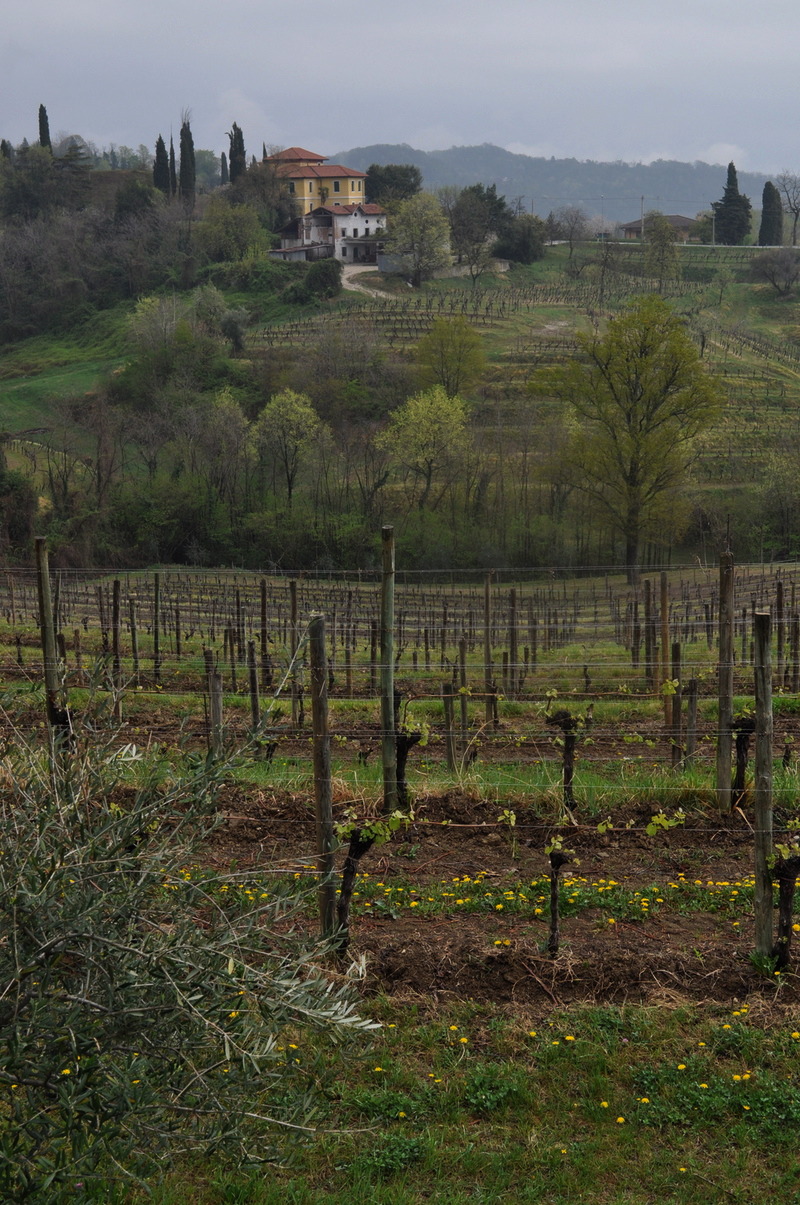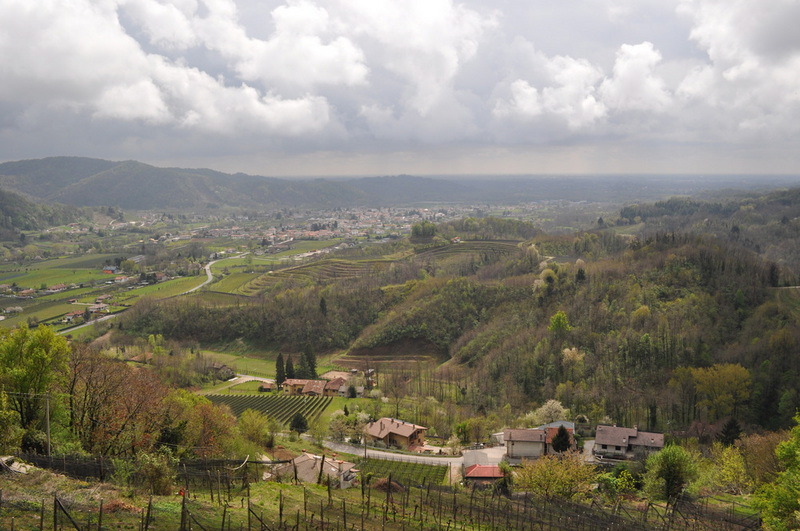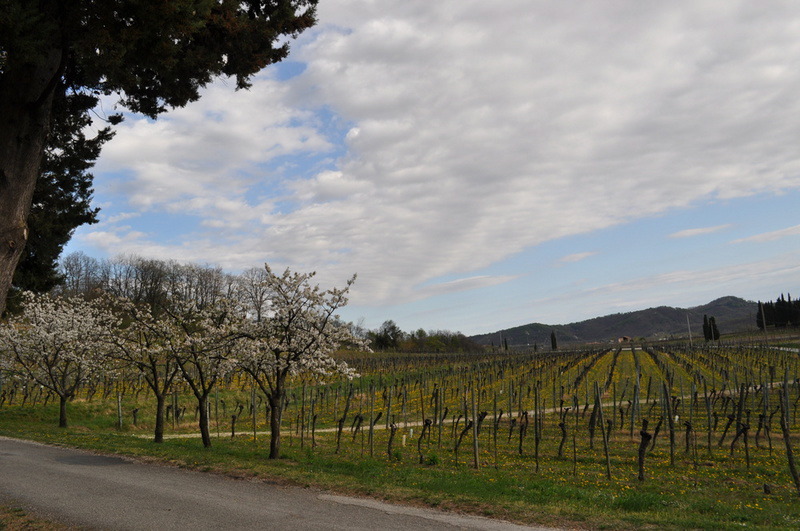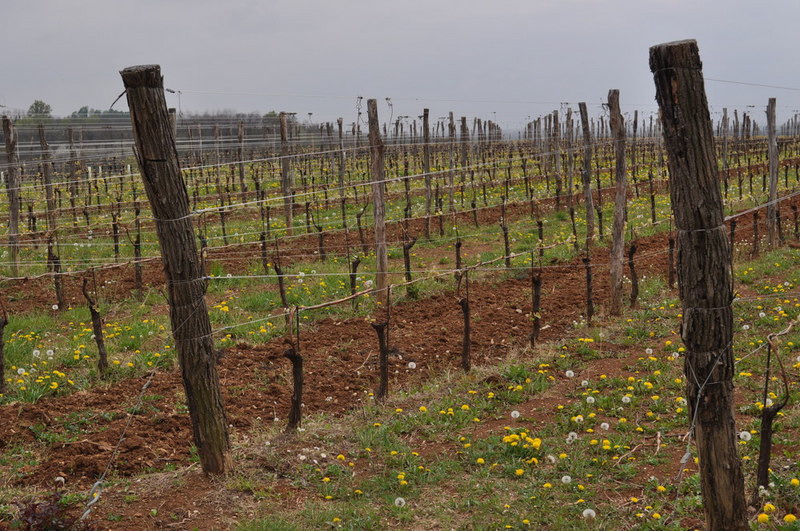In traveling through Friuli-Venezia Giulia, and tasting the wines of Colli Orientali del Friuli, I became fascinated with the fact that the region itself seems to support more natural approaches to vineyard maintenance and wine production. In closing my series on the #cof2012 visit to the appellation I want to indulge my own geeky tendencies and consider the way in which environment, soil, and specifically calcium intersect to encourage the possibility of this more natural approach, as well as the aging potential of the wines. Doing so will lead too to thinking on the controversial, and somewhat esoteric idea of minerality in wine.
Wine Growing Practices in Relation to the Surrounding Environment
Approaching Solder
Friuli-Venezia Giulia celebrates generally cool temperatures and drying bora wind that offer an ideal climate for growing grapes, plus the drying conditions that allow for maintaining healthy fruit. As a result, it is generally easier for wine makers in the region to use more natural practices in the vineyard since there is less need to intervene to avoid fungal or mildew infections on the plant. However, the region offers other natural supports for less interventionist and more chemical free wine production as well.
Many of the smaller wineries also take advantage of their other environmental conditions to develop a more natural wine making practice. As described to us by Ivan Rapuzzi of Ronchi di Cialla, by maintaining vineyards near forests, the pest-predator balance found in the forests is extended to the vineyards as well. That is, many of the pests that strike grape vines, causing detrimental effect for wine makers, can actually also be found among the plants and trees of a forest. The difference in the forest environment is that a balance of pest and predator is more readily maintained so that the overall health of the forest stands even in the face of including some various plant pests. Vineyards, on the other hand, are often designed in such a way that isolate grape vines from other plant life, and as such remove them from the kind of natural balance Rapuzzi describes of the forest. The result is that vines become more vulnerable to pests as they are also in these conditions isolated from the predators that would rid plants of their parasites. By planting grape vines in close proximity to forests the predator population of the forest is available to the neighboring grape vines as well, thus keeping troublesome pests largely at bay. Additionally, proximity to forests helps to keep temperatures well regulated for the steady ripening of fruit.
However, the overall environment found in temperatures, winds, and botanical balance are only a portion of the story for the wines of Colli Orientali del Friuli.
Considering Colli Orientali’s Soils
The View at Le Vigne di Zamo
The ponca of Colli Orientali originates from its years as an Eocenic sea bed. The waters reached almost to the southern rim of the Julian Alps, gathering a rich blend of minerals in their soils, and also a high concentration of organic materials as sediment gathered on the sea floor over time. When the sea retreated, the hills and valleys of the eastern side of Friuli (including both the appellations of Colli Orientali del Friuli and Collio) retained soils valuable for growing low yield grapes with concentrated flavors and rich mineral elements.
The wines of Colli Orientali del Friuli are known for having superb aging ability, with the whites in particular matching the aging ability of those from Champagne and Burgundy. In meeting the Rapuzzi family of Ronchi di Cialla, Ivan discussed with us their own production history testing various techniques and their effects on wine as it ages. What they discovered from the practice was that the less the family intervened in the cellar the more readily the wines lasted well in the bottle over time. Ronchi di Cialla wines are known for doing quite well over extended periods, whether the wine be red, white, or a sweet wine. In their view, this reality confirms that the reason for Colli Orientali’s age-ability originates in the soils themselves, since it is clearly not merely a matter of the strength of individual grape types, for example.
Wine makers throughout Colli Orientali discussed their pride in the value that the soil imparts to their wines. The area consistently produces wine with a distinct mineral zing that shows itself readily in any of the lower intervention wines, and stands up against the more interventionist production techniques of other wine makers as well (that is, as Stuart George would put it, some wines have more make-up).
In considering both the sustainability in the bottle, and the mineral zing of the region’s wines, the wine makers regularly stated that it was the region’s soils that did the work for them, and that, in particular, the high proportion of calcium accomplished these feats.
The Role of Calcium in Root Development
The View from the Top of Ramandolo
Colli Orientali del Friuli celebrates a calcium rich marl, their ponca, which uniquely contributes to the quality of the region’s wines. The presence of calcium in particular stands as important here. Though the calcium rich soils of the eastern side of Friuli-Venezia Giulia are generally understood as too poor for grain or cereal type crops, the soils offer beneficial characteristics for grape vines.
Calcium plays a tricky balance in its benefits for vine growth. On the one hand, calcium rich soil does well at absorbing water during heavy rains (rather than rain simply running off the surface), while then retaining moisture for good periods after, during dry weather. The retention of water in this way allows the security of vine growth over time. However, on the other hand, during longer dry periods the cells of such soils dry up and shrink as the water evaporates, causing cracking and tightening of the ground (though not necessarily in a visible way). While the roots of the vines have been nourished by the water retention of the soil, they now are able to dive deeper through the earth that, due to its cellular shrinking, readily breaks up and makes room for the roots to move through. Thus, the vines receive the nourishment necessary to achieve basic root growth, and then have ease enough to achieve deeper root growth. In pushing into deeper earth, the vines are also forced to struggle in a way that impacts the production of the fruit, concentrating the juices of them and thereby also their flavors.
The benefits of calcium rich soils, however, extend beyond mere questions of moisture.
The Role of Calcium in Vine Development and Fruit Health
Vineyards at Solder
Calcium rich earth is generally more porous, or permeable at a small scale in a way that allows greater ‘openness’ (to speak loosely) within the soil structure. These small spaces serve to provide room for root hairs to more readily absorb nutrients directly from the earth itself. The more permeable the soil is in this way the less the plant must compete to take up the minerals needed and already present in the soil. That is, it is not enough for necessary minerals to be present in the soil. The proper conditions that support the plants ability to absorb those minerals must also be present. Soil permeability is one of those conditions.
Calcium also directly impacts the pH level of the soil, keeping the ground from being overly acidic. With more basic (less acidic) soils, vine roots are more able to take up necessary minerals that support the overall plant health and development. In this way, the presence of calcium in the soil allows plants to absorb a healthy balance of calcium, potassium, magnesium, and sodium.
The absorption of these minerals strengthens not only the overall health of the plant, but also the plant’s resistance to external pests. When absorbed by the vine, calcium strengthens the cellular walls of the plant itself, thereby reducing the potential impact of both external pests and enzymes, such as those caused by mildew or fungus. In testing of grapes, calcium actually shows at detectable levels within the fruit skin, and there has the effect of reducing the permeability (and also therefore the susceptibility) of the grape.
Testing has also shown that the absorption of minerals by the vine from the soils directly impacts both the acidity of the grapes, and so then also the pH of the wine itself. In this way, the mineral qualities of the soil do directly impact the sensory qualities of the wine as well–that is, the flavor and structure of the wine. However, the minerals within the soil also impact the degree to which a vineyard manager, and wine maker are able to achieve a less interventionist, and non-petro-chemical approach in making their wine. That is, in the case of calcium rich soils, it is easier for vineyard managers to use less interventionist vineyard maintenance, and to avoid petro-chemical treatments as the balance of the vineyard translates into the pest-resistance of the vines and fruit.
The Question of Minerality in Wine
Vineyards at Betulle
While scientific studies have clearly shown that the minerals within the soil directly impact the pH of the grapes in a manner that persists in the wine produced from that fruit (allowing for variations from production choices, of course), controversy around the question of a wine’s so-called “minerality” remains. What is important to point out here, in the midst of this particular discussion, is that minerality as a descriptor of a wine’s particular qualities is not necessarily a claim of the literal minerals present within that wine. That is, there are at least two different concepts operating here–on the one hand, the role of literal minerals on wine, and, on the other, an idea of a flavoral and textural quality experienced as something like minerals, which we reference as minerality.
Let me give away the beans and cheese of the point I’m going to make, and then make my argument for that point. Here it is, the beans and cheese: My point is that these two things–literal minerals, on the one hand, and minerality in wine, on the other–might have a direct correlation such that literal minerals in the soil are tasted as minerality in the wine, but whether that turns out to be the case, or not, in stating that one tastes minerality, one need not also be claiming that there are literal minerals being tasted. (The question of a possible link is not yet proven and many people because of that argue the correlation is not there–such a claim, however, is sloppy science. Science has not disproven the link.)
Now let’s turn to the clarification of this point.
First, let us consider the role of literal minerals on wine. It is without doubt that differing soil types carry different minerals, which are not only necessary for the growth of any plant, but also that those minerals within the soil directly impact the way in which that plant grows. Further, the mineral presence of the soil, and the soil permeability, not only allow for plant growth but also distinctly impact the quality of the fruit grown by the plant. In the case of wine, the pH levels and chemical balance found within the fruit are a result of the way in which the plant is able (or not) to take up calcium, potassium, magnesium, and sodium from the soil. So, the minerals of the soil simply are relevant to the wine that is produced from vines growing in that soil. Notice, however, that this is not a claim that we literally taste the individual minerals themselves in any direct way. (In fact, the results of most studies would seem to indicate that the levels of any of these four minerals in wine is too low for us to detect as anything like specific flavors.)
Second, let us consider the idea of minerality in wine. We can understand the word minerality, loosely speaking, to reference a sensory experience of something like the flavors and scents of particular minerals themselves, without that experience having to have a direct link to those literal minerals. It is often considered a peculiar description because it seems as though we don’t go around eating, tasting, or smelling the kinds of things wine tasters reference when discussing the notion of minerality. To understand what I mean, we can simply list off different examples of wine terms that are types of apparent minerality: the smell of chalk in champagne; the taste of river stones in a cool vintage Brunello; the scent of petrol in Riesling; the flavor and bouquet of graphite in a rich Bordeaux. In such cases, the term minerality is meant to capture a sensory experience had through the smelling and tasting of a particular wine, a sensory experience where we feel as though we are recognizing something very much like chalk, river stones, petrol, or graphite.
There has been much discussion (much of it argumentative) recently (and indeed for a long time) on the seemingly esoteric notion “minerality.” Many of the arguments depend on a mistake of concept–that is, they assume that the description “minerality” is being stated as a claim of actual mineral levels of the wine itself; and, further, that if there is no such link to actual minerals, then the concept minerality must be faulty. Such a link would depend on testing the wines themselves for those mineral levels. However, continuing to utilize the idea of minerality as a description of a particular wine’s qualities does not genuinely depend upon whether or not there is an actual link between the experience of something like mineral scents and flavors, and there being those actual minerals present in that wine. This is a mistake of assuming that our subjective language of experience can only be supported by systematic scientific legitimization. That is not only false, but also a misunderstanding of (a) the purposes of science, (b) how we experience the world, and (c) how we communicate such experience with each other.
As is no doubt obvious by now, I am fascinated by such questions as, is there a link between minerality in wine and minerals from the soil that wine’s vines were grown in? I honestly want people to continue scientifically studying this. Or, as another question, which I’ve addressed in this post, in what way does calcium impact the growth of vines and the qualities of the wine those vines produce? But, I am equally as fascinated by our own experience of the world, and how we communicate and share with each other such experience.
As an example, scientific studies have pointed out that apples, potatoes, and onions have a chemical make-up that should mean they taste the same. My experience of these three foods, however, is something more like tart and/or sweet for apples, earthy and watery for potatoes, and sweet, sharp, and/or biting for onions (it is apparently the smell of these foods that causes us to distinguish them). In the wines of Colli Orientali del Friuli, however, I taste a minerality I can’t help but love.






Great piece. It is funny how nudgy mineral as a descriptor can be. I have read things that dismiss the use of mineral in describing your wine experience because mineral is not volatile and therefore cannot give off a scent. I like how you distinguished between mineral actually being present in the grape and the sense of mineral in the wine and how they are two totally different things.
Very interested in your discussion of minerality; the term dripped incessantly into my tasting notes throughout the MW programme, and then they gave me the tasting prize; just shocking how far misappropriation can get you!
It has taken ten years working in Champagne for me to get a grasp of what our Chef de Cave means by “minerality”, or at least to get his agreement when I toss the term back to him.
First off, the term is applied both to vin clair and the finished wines after disgorgement, so one needs to be cautious about attributing it to reductive flavours arising out of the prise de mousse alone. The reference is to those bitter salt characters that hinge together the flavours at the front and back of the palate. Tasting through 20 or so vin clair before assemblage, it is interesting to note than the intensity of this character more or less coincides with the echelle system, that is, it’s greater in Pinot from Verzenay and Ay, that it is in Pinot from Tauxieres. Given that the echelle system is pretty much built upon the quantity and quality of the chalk in the subsoil, there appears to be something of a significant correlation between flavour and chalk that’s begging for a hypothesis.
I am with you on the link between soil structure, calcium, root generation, and capillary rise as a means of explaining the different journeys to ripeness taken by vines in adjacent appellations. I think these insights into soil structure give a pretty comprehensive account of how terroir works on the Cote de Nuits, but I would be being disingenuous if I said it was the whole story, because when I taste wines from Burgundy (and the Haut Medoc, and the Loire) I am acutely aware of this additional, abrasive mineral component that doesn’t seem obviously attributable to differences in berry size or skin thickness.
Tasting Champagne, good Champagne, I am struck by how the wines can be simultaneously refreshing – acidulous, citrus, sparkling – and, as a consequence of this bitter salt component, desiccating. Moreover, the fact that these qualities are in some sense linked, that there is a degree of positive reinforcement between the acid and the alkali in this instance, just seems to add to the finished wines’ intensities.
The Loire is another region where this mineral gyre is pronounced. I once tasted a range of Mont Damnes Sancerre with some French sommeliers, exiled in London. The wines had them pining for home; reaching for the ruby slippers; sure they were mineral, but I was alone in finding the wines lacking in pleasure. For me this mineral character was just too isolated and dominant. Like salt on food, the mineral component not only adds its own flavour, it also enhances and draws together other flavours that are present within the wine, like a lens.
Having been away from the US for a long time, I am not sure how these insights stack-up with your own experiences. In the past I worked with Paul Draper, and tasting Ridge Monte Bello today, I always encounter the very same mineral element that I find in the best wines of the Haut Medoc. This characteristic doesn’t register as graphite, but it’s more like a feint saline undertow that acts as a fulcrum between the wine’s structure and flavours. Is it limestone? Similarly, a few days ago, I tasted David Ramey’s Chardonnay against Caroline Morey’s Meursault, and the main difference was the abrasive, sherbet element that was so plentiful in the Morey wine, but entirely missing in the Sonoma bottle.
All this intrigues me because for many years I tried to introduce French winemakers to New World wines, with little success. Now, having been thoroughly inculcated into the French wine empire, I have also come to share their prejudices. A wine without this elusive bitter-salt mineral component just seems incomplete. Intensity and concentration are profoundly different terms when applied to wines.
The above, then, is my situ understanding of minerality. It is as definitive as I can make it, but I can’t, as yet, explain it. Yes, it seems tied to limestone in some way (and France is superficially 80% limestone) but what happens beyond this obvious association I cannot say.
Keep salting the caramel
Valerie Saxton’s paper on Calcium in Viticulture is pretty good if you want a referenced account of the relationship between roots and soil hydrology and calcium.
I have some detailed data from Burgundy, Champagne and the UK, which does contradict the idea of high cation availabilty in high pH soils as the clay-humus complexes are just so base-saturated with calcium, there’s no space for anything else. As ever with soils, it’s the distiction between capacity,availabilty and extractability that’s at issue.
Hi John,
Thank you for taking the time for such a thoughtful response. It was a wonderful surprise to find your comment here.
Yes, the article you reference by Valerie Saxton is quite good, and referenced within the post here–I used imbedded links to make the online format less cumbersome. It’s a good two part article that looks at the effects of the presence of calcium in soils on vines more generally in the first part, and then examines specific regions, their soils and wines, in the second.
Definitely though, as you say above in your shorter comment–the proportions with other minerals are crucial (as with human consumption, the calcium to magnesium ratio matters to how vines are impacted by the calcium presence), and the role of calcium seems to largely be for the sake of the absorption and benefit of other minerals in the soil as well, as well as the unique impact calcium (in certain forms at least) can have in the presence of water allowing easy drainage while also retention at a micro-level, while also being mildly poisonous for the vines, thus forcing vines to grow deeper while also supporting water absorption at the level of root ‘hairs’.
I am very interested too in your reflection on what minerality amounts to (how we experience or taste it) in a wine, and in which wines it shows up or doesn’t–the idea of it bringing an extra element that is satisfying, and sorely missed when not present, I agree with you there. I’ve been talking recently with a number of wine makers and wine scientists on the question of minerality and just honing in on what phenomenon we are even referring to in our use of the word is a challenge. Thank you for taking some time to reflect on your own usage here.
I very much appreciate you sorting through these ideas here. Thank you.
[…] grapes. The quality of land through the area, with its unique soil type, known there as ponca, along with the high acidity driving climate, gives even non-native grapes a form of expression […]
I have always had a problem with the term minerality, primarily because its use is too often vague or inconsistent. I like my wine terms to be replicable, and if possible demonstrative in the lab.
The one thing that strikes me, and is reinforced especially in John’s use of the term, is that minerality has some relationship to TA and pH. The perception of salty qualities in wine has always corresponded with high pH, for me. I can see that being a source of the term minerality, but then why are tart wines like Meursault often described for their minerality? I am much more likely to get high TA, lower pH “licking a silver spoon” perception from these wines, then the salt that John mentions.
A great discussion on calcium in the soil, and how it may be the secondary characteristics, such as root development, rather than primary induction of minerals into the plant and subsequently into the grape, that may lead to minerality in wine. I would posit that the microbiology of all soils is also greatly affected by the mineral content, and that this too play a leading role, especially in the absorption of nutrients through the root system. I feel not enough attention is paid to this aspect of the system.
A well written article that acknowledges the problem with the term minerality, especially as defined by any given local winemaker, while still allowing for the existence of some characteristic that may yet be defined universally.